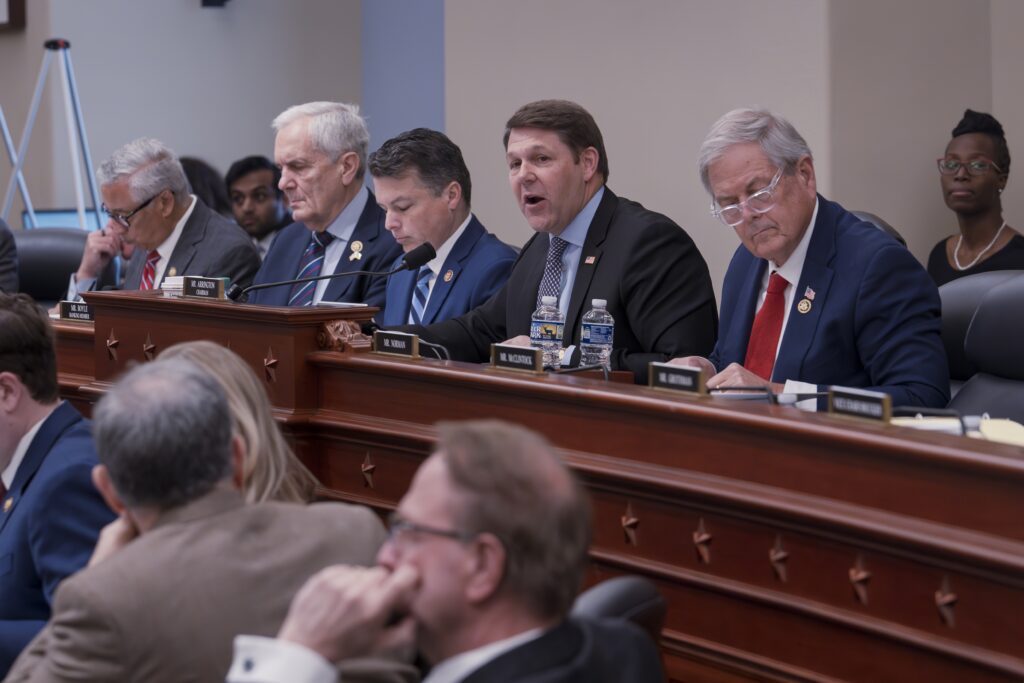Let’s be honest. Republicans aren’t cutting Medicaid − but they should.
If, as Democrats fear, Republicans were to reduce future Medicaid spending $880 billion by 2035, the program’s annual growth rate would merely fall from 4.5% to 3%. You know an entitlement program is enormous when 1.5 percentage points of growth equals almost $1 trillion.
President Donald Trump promises to balance the budget without touching Medicaid. But keeping both promises is impossible. Unless Congress significantly cuts federal health care subsidies, it could trigger a debt crisis with wrenching cuts that hit Medicaid enrollees hardest.
Balancing the budget without touching health care would require 40% cuts to all other federal spending. There is no practical way to balance the budget while sparing health care subsidies.
Trump on May 20 warned House Republicans once again not to cut Medicaid even as he pressed them to pass a major tax cut and spending bill this week.
National Debt Threatens Americans’ Financial Security
Yet, the rapidly growing federal debt threatens staggering obligations on future taxpayers. Retiring federal debt held by the public—now $30 trillion or 100 percent of GDP, a peacetime record—would require a tax of $236,000 per household.
Runaway spending adds another 6 percent of GDP to the pile each year. As shares of GDP, current federal revenues are roughly equal to the historical average (17.1 percent vs. 17.3 percent, respectively), but spending is significantly higher than the historical average (23.3 percent vs. 21.1 percent).
The main driver in increased federal spending is health care subsidies. At more than $1.8 trillion annually, health care is the largest category of federal spending − larger than Social Security ($1.7 trillion), national defense and veterans’ benefits ($1.3 trillion), or interest on the debt ($952 billion).
Balancing the budget without touching health care would require 40% across-the-board cuts to all other spending. There is no practical way to balance the budget while sparing health care subsidies.
Failing to cut now would mean devastating cuts later. Bond markets are already inching toward curtailing or eliminating Congress’ ability to finance those subsidies via borrowing. On May 16, Moody’s Ratings downgraded the U.S. credit rating, citing our nation’s refusal to address the federal government’s enormous budget deficits.
If our government hits its borrowing limit, a debt crisis would produce severe inflation, economic recession and wrenching cuts to federal expenditures.
The resulting cuts would threaten access to health care for all 120 million people − more than one in three Americans − who receive Medicare, Medicaid, CHIP or Obamacare subsidies. The cuts could easily wipe out any access gains from Obamacare. Medicaid would suffer the deepest cuts, because poor people have less political power. If you think today’s Medicaid work requirements are oppressive, just wait.
Both Political Parties Are Spending Recklessly
Congress’ ongoing refusal to cut federal health care subsidies is madness. The best evidence suggests Congress could cut health care subsidies by one third or more without harming health. Further reforms could make health care more universal. Yet both political parties continue to play games.
Democrats say the U.S. health sector is uniquely inefficient and rife with waste. Democrats even attack wasteful federal subsidies, but then try to use the savings to create new wasteful subsidies (see Obamacare, the Inflation Reduction Act and Kamala Harris’ Medicare-expansion proposal).
Yet, when Republicans propose that Medicaid grow at 3% annually instead of 4.5%, Democrats suddenly act like cutting waste means everyone will die.
Democrats’ actual fear is that cutting Medicaid would expose its unpopularity. If current Medicaid spending levels were popular, voters would support the taxes necessary to replace federal cuts with state funds. Every time Democrats assume states won’t replace federal cuts −every time they equate federal cuts with coverage losses − they are implicitly admitting that current Medicaid spending levels lack popular support.
Meanwhile, Republicans plan to increase spending on every federal health care subsidy program, every year. Republicans are skirting budget rules to preserve Obamacare subsidies for people earning up to $600,000 annually. Trump refuses to cut Medicare, the most inefficient part of the most inefficient health sector in the world.
Once upon a time, Republicans had principles. In the 1990s, they pushed Medicaid and Medicare reform. They passed legislation establishing Medicaid block grants. I can’t believe I’m pining for Newt Gingrich.
The fundamental problem is that Congress hears more from the ideological supporters and industry recipients of government subsidies than from the taxpayers who bear the cost.
The health care industry has outspent every other economic sector on congressional lobbying every year since 1999. It spends nearly six times what the defense industry spends. Their objective is to expand government subsidies that protect high-cost but low-quality providers who would never survive in a free market. Since Congress need not increase taxes to placate the industry, taxpayers have scant incentive to resist.
Averting a debt crisis may therefore require that states change Congress’ incentives by adding a balanced-budget amendment to the U.S. Constitution. (Those who say amending the Constitution is impossible have never tried cutting health care subsidies.)
A balanced-budget amendment would shift the tax burden of health care subsidies from future generations to current taxpayers, who might finally show up to demand cuts. Cutting health care subsidies without an amendment may be a pipe dream.
souece: CATO INSTITUTE




